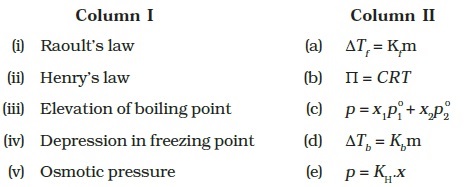1.Calculate the molality of a solution that contains 51.2 g of naphthalene, C10H8, in 500 mL of carbon tetrachloride. The density of CCl4 is 1.60 g/mL.
(a) 0.250 m
(b) 0.500 m
(c) 0.750 m
(d) 0.840 m
2. What is the molality of a solution labeled "8.6% glucose (C6H12O6) by weight?" (Note: If the question does not give the solvent, assume it is water.)
(a) 0.26 m
(b) 0.34 m
(c) 0.44 m
(d) 0.52 m
3. Calculate the mole fraction of C2H5OH in a solution that contains 46 grams of ethanol, C2H5OH, and 64 grams of methanol, CH3OH.
(a) 1/3
(b) 0.42
(c) 1/2
(d) 2/3
4. Which observation(s) reflect(s) colligative properties?
(I) A 0.5 m NaBr solution has a higher vapor pressure than a 0.5 m BaCl2 solution.
(II) A 0.5 m NaOH solution freezes at a lower temperature than pure water.
(III) Pure water freezes at a higher temperature than pure methanol.
(a) only I
(b) only II
(c) only III
(d) I and II
5. The vapor pressure of pure water at 85oC is 434 torr. What is the vapor pressure at 85 degree Celsius of a solution prepared from 100 mL of water (density 1.00 g/mL) and 150 g of diglyme, C6H14O3, a nonvolatile substance?
(a) 361 torr
(b) 390 torr
(c) 425 torr
(d) 388 torr
6.The vapor pressure of a solution containing a nonvolatile solute is directly proportional to the
(a) molality of the solvent.
(b) osmotic pressure of the solute.
(c) molarity of the solvent.
(d) mole fraction of solvent.
7. If 4.27 grams of sucrose, C12H22O11, are dissolved in 15.2 grams of water, what will be the boiling point of the resulting solution? (Kb for water = 0.512 oC/m) (Note: If the Kf and Kb are not given on the exam, you can find them on the back of the exam envelope.)
(a) 101.64 0C(degree Celsius)
(b) 100.42 0C
(c) 99.626 0C
(d) 100.73 0C
8. What are the ideal van't Hoff factors for the following compounds:
Ba(OH)2, C6H12O6, K3PO4, HNO3 ?
(a) 1, 1, 1, 1
(b) 2, 1, 2, 2
(c) 3, 1, 4, 2
(d) 6, 3, 5, 5
9. Calculate the approximate initial boiling point (in oC) of a solution of 285 g of magnesium chloride in 2.0 kg of water. (Assume complete dissociation of the salt.)
(a) 103.1 0C (Degree Celsius)
(b) 101.6 0C
(c) 102.3 0C
(d) 100.8 0C
10. A solution made by dissolving 9.81 g of a nonvolatile nonelectrolyte in 90.0 g of water boiled at 100.37 oC at 760 mm Hg. What is the approximate molecular weight of the substance? (For water, Kb = 0.51 oC/m)
(a) 240 g/mol
(b) 150 g/mol
(c) 79 g/mol
(d) 61 g/mol
(e) 34 g/mol
11. What is the freezing point of an aqueous 1.00 m NaCl solution? (Kf = 1.86 oC/m) (Assume complete dissociation of the salt.)
(a) -1.86 0C (degree Celsius)
(b) +1.86 0C
(c) -3.72 0C
(d) -0.93 0C
12. A 17.3 mg sample of an organic compound (a non-electrolyte) was ground up with 420 mg of camphor to form a homogeneous mixture melting at 170.0 oC. What is the apparent formula weight of the organic compound? (Kf of camphor = 37.7 oC/m, m.p. of camphor = 178.4 oC) (Note: This is a freezing point depression problem - note the Kf of camphor - camphor is the solvent.)
(a) 353 g/mol
(b) 285 g/mol
(c) 231 g/mol
(d) 185 g/mol
13. Calculate the osmotic pressure associated with 50.0 g of an enzyme of molecular weight 98,000 g/mol dissolved in water to give 2600 mL of solution at 30.0 oC.
(a) 0.484 torr
(b) 1.68 torr
(c) 1.96 torr
(d) 3.71 torr
14. A 250 mL solution containing 21.4 g of a polymer in toluene had an osmotic pressure of 0.055 atm at 27 oC. What is the apparent formula weight of the polymer?
(a) 15,000 g/mol
(b) 18,000 g/mol
(c) 26,000 g/mol
(d) 38,000 g/mol

